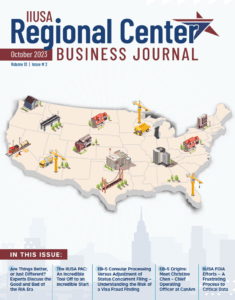On Wednesday February 3rd from 1:00-2:30pm est, the U.S. Citizenship and Immigration Services (USCIS) will hold a stakeholder to discuss the EB-5 Immigrant Investor Program. During this teleconference, USCIS officials will share EB-5 Immigrant Investor Program updates and respond to stakeholder questions. View PDF of Teleconference Invitation.
This engagement is part of ongoing efforts by the USCIS EB-5 Immigrant Investor Program Office (IPO) to enhance dialogue with EB-5 stakeholders. See below for the full list of questions proposed by IIUSA to the USCIS Customer Service and Public Engagement Directorate. To view the questions in PDF format, click here.
1. What are the USCIS intentions with regard to the August 2015 Draft Policy Memo on sustaining the investment? Could you give the stakeholders an update on this?
2. Given that I-829 processing times are beyond 12 months but I-829 receipts are only valid for 12 months, is there a plan to update documents so they allow people to continue to document conditional residency without having to renew the I-829 receipts?
3. EB-5 practitioners have noted examples in which USCIS is ignoring the deference policy outlined in the May 2013 Policy Memo. While acknowledging you cannot address specific cases, can you summarize the factors that would cause USCIS to not grant deference? Please discuss how IPO is applying the deference policy in the May 2013 Memo. For example, we are aware of at least one case that has project preapproval and over 60 I-526 petition approvals, yet USCIS has issued requests for evidence (RFEs) and notices of intent to deny (NOIDs) in subsequent I-526 petitions in the same project. These RFEs and NOIDs do not allege material change, legal deficiency, or fraud.
4. Please detail staffing levels at USCIS responsible for administering EB-5 and how they are assigned by work categories. Please share an IPO organization chart if possible. Can you identify plans to increase staffing, by work category and over what time frame?
5. Describe the decision factors that go into deciding how IPO allocates its EB-5 staff and other resources.
6. Does the USCIS employ dedicated I-829 adjudication staff? If yes, does this staff communicate with the staff members assigned to I-526 adjudication to avoid inconsistencies in adjudications?
7. How many EB-5 petitions are pending by application category?
8. Please describe in detail how the USCIS calculates its average processing times for the various EB-5 application categories? For example, if the IPO issues an RFE on an EB-5 case, how does that factor into calculating the average processing time? Is USCIS willing to post publicly the formula with definitions for each variable utilized?
9. Can USCIS provide more detailed average processing times for I-924 applications based on whether they are for 1) a new regional center, 2) amendment for an existing center in connection with a new project business plan, 3) service area expansion for an existing regional center with a hypothetical project, and 4) approval of organizational changes to a regional center’s ownership or control?
10. Can USCIS confirm that in all cases it assigns and adjudicates applications in the chronological order submitted? If it does not, what would be the reasons for adjudicating applications outside of this protocol?
11. USCIS has indicated previously that they were considering additional avenues by which they would communicate the adjudication status of applications and potential ways in which regional centers could communicate directly with staff assigned to their applications. Are these still under consideration? If so, what is the status and can you share some thoughts as to what if any of these new approaches may be adopted and when?
12. Is there a way to avoid submitting the same set of project documents for each individual investor?
13. Does the USCIS intend to provide further guidance in the near term on when an investor’s EB-5 investment is considered a loan and when it is considered a gift?








